Evaluating the Impression: Roman Architecture on Modern Designs
VerifiedAdded on 2020/02/14
|12
|4889
|388
Essay
AI Summary
This essay delves into the profound and lasting impression of Ancient Roman architecture on modern building design. It explores the historical context of Roman architectural innovations, including the widespread use of concrete, arches, and columns, and their influence on contemporary structures. The essay highlights specific examples, such as the White House and the Federal Hall, to illustrate the enduring legacy of Roman architectural elements in modern buildings. Furthermore, it examines the evolution of architectural styles, materials, and techniques, emphasizing how the Roman approach to design continues to shape the aesthetics and functionality of buildings worldwide. The essay provides a comprehensive overview of how Roman architectural principles have been adapted and reinterpreted throughout history, demonstrating their continued relevance in the field of architecture.
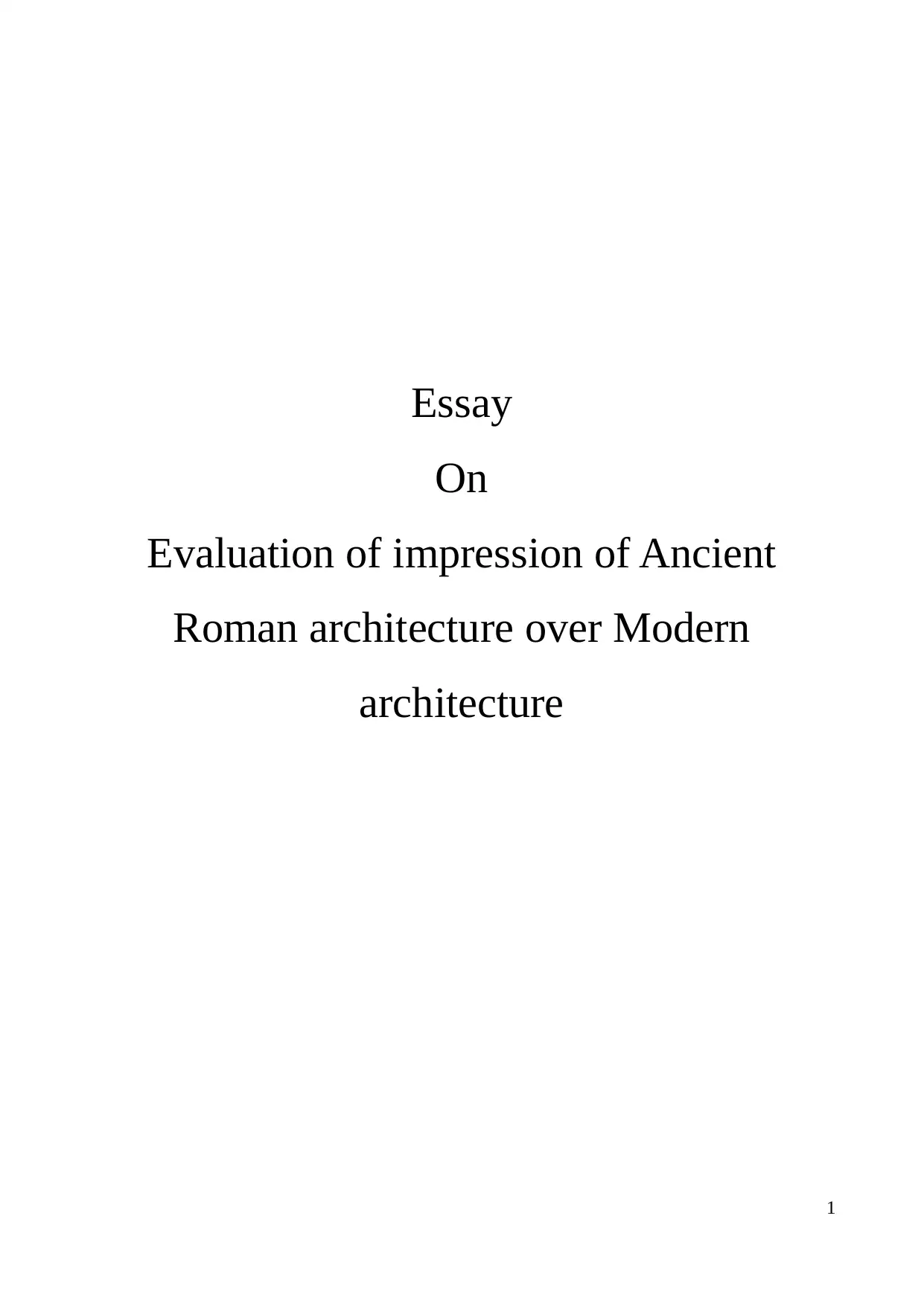
Essay
On
Evaluation of impression of Ancient
Roman architecture over Modern
architecture
1
On
Evaluation of impression of Ancient
Roman architecture over Modern
architecture
1
Paraphrase This Document
Need a fresh take? Get an instant paraphrase of this document with our AI Paraphraser

TABLE OF CONTENTS
INTRODUCTION................................................................................................................................3
MAIN BODY.......................................................................................................................................3
CONCLUSION....................................................................................................................................8
REFERENCES.....................................................................................................................................9
2
INTRODUCTION................................................................................................................................3
MAIN BODY.......................................................................................................................................3
CONCLUSION....................................................................................................................................8
REFERENCES.....................................................................................................................................9
2
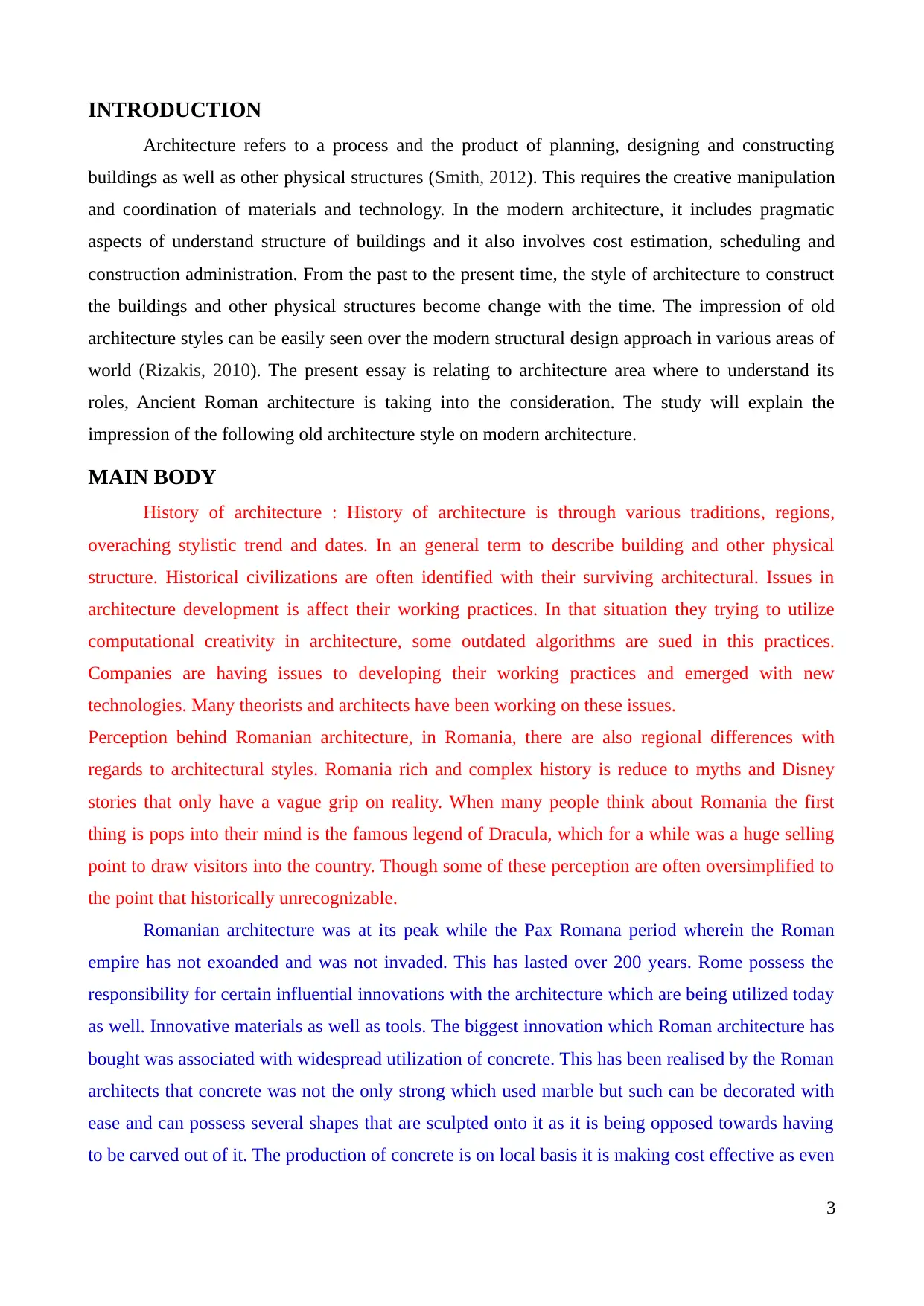
INTRODUCTION
Architecture refers to a process and the product of planning, designing and constructing
buildings as well as other physical structures (Smith, 2012). This requires the creative manipulation
and coordination of materials and technology. In the modern architecture, it includes pragmatic
aspects of understand structure of buildings and it also involves cost estimation, scheduling and
construction administration. From the past to the present time, the style of architecture to construct
the buildings and other physical structures become change with the time. The impression of old
architecture styles can be easily seen over the modern structural design approach in various areas of
world (Rizakis, 2010). The present essay is relating to architecture area where to understand its
roles, Ancient Roman architecture is taking into the consideration. The study will explain the
impression of the following old architecture style on modern architecture.
MAIN BODY
History of architecture : History of architecture is through various traditions, regions,
overaching stylistic trend and dates. In an general term to describe building and other physical
structure. Historical civilizations are often identified with their surviving architectural. Issues in
architecture development is affect their working practices. In that situation they trying to utilize
computational creativity in architecture, some outdated algorithms are sued in this practices.
Companies are having issues to developing their working practices and emerged with new
technologies. Many theorists and architects have been working on these issues.
Perception behind Romanian architecture, in Romania, there are also regional differences with
regards to architectural styles. Romania rich and complex history is reduce to myths and Disney
stories that only have a vague grip on reality. When many people think about Romania the first
thing is pops into their mind is the famous legend of Dracula, which for a while was a huge selling
point to draw visitors into the country. Though some of these perception are often oversimplified to
the point that historically unrecognizable.
Romanian architecture was at its peak while the Pax Romana period wherein the Roman
empire has not exoanded and was not invaded. This has lasted over 200 years. Rome possess the
responsibility for certain influential innovations with the architecture which are being utilized today
as well. Innovative materials as well as tools. The biggest innovation which Roman architecture has
bought was associated with widespread utilization of concrete. This has been realised by the Roman
architects that concrete was not the only strong which used marble but such can be decorated with
ease and can possess several shapes that are sculpted onto it as it is being opposed towards having
to be carved out of it. The production of concrete is on local basis it is making cost effective as even
3
Architecture refers to a process and the product of planning, designing and constructing
buildings as well as other physical structures (Smith, 2012). This requires the creative manipulation
and coordination of materials and technology. In the modern architecture, it includes pragmatic
aspects of understand structure of buildings and it also involves cost estimation, scheduling and
construction administration. From the past to the present time, the style of architecture to construct
the buildings and other physical structures become change with the time. The impression of old
architecture styles can be easily seen over the modern structural design approach in various areas of
world (Rizakis, 2010). The present essay is relating to architecture area where to understand its
roles, Ancient Roman architecture is taking into the consideration. The study will explain the
impression of the following old architecture style on modern architecture.
MAIN BODY
History of architecture : History of architecture is through various traditions, regions,
overaching stylistic trend and dates. In an general term to describe building and other physical
structure. Historical civilizations are often identified with their surviving architectural. Issues in
architecture development is affect their working practices. In that situation they trying to utilize
computational creativity in architecture, some outdated algorithms are sued in this practices.
Companies are having issues to developing their working practices and emerged with new
technologies. Many theorists and architects have been working on these issues.
Perception behind Romanian architecture, in Romania, there are also regional differences with
regards to architectural styles. Romania rich and complex history is reduce to myths and Disney
stories that only have a vague grip on reality. When many people think about Romania the first
thing is pops into their mind is the famous legend of Dracula, which for a while was a huge selling
point to draw visitors into the country. Though some of these perception are often oversimplified to
the point that historically unrecognizable.
Romanian architecture was at its peak while the Pax Romana period wherein the Roman
empire has not exoanded and was not invaded. This has lasted over 200 years. Rome possess the
responsibility for certain influential innovations with the architecture which are being utilized today
as well. Innovative materials as well as tools. The biggest innovation which Roman architecture has
bought was associated with widespread utilization of concrete. This has been realised by the Roman
architects that concrete was not the only strong which used marble but such can be decorated with
ease and can possess several shapes that are sculpted onto it as it is being opposed towards having
to be carved out of it. The production of concrete is on local basis it is making cost effective as even
3
⊘ This is a preview!⊘
Do you want full access?
Subscribe today to unlock all pages.

Trusted by 1+ million students worldwide
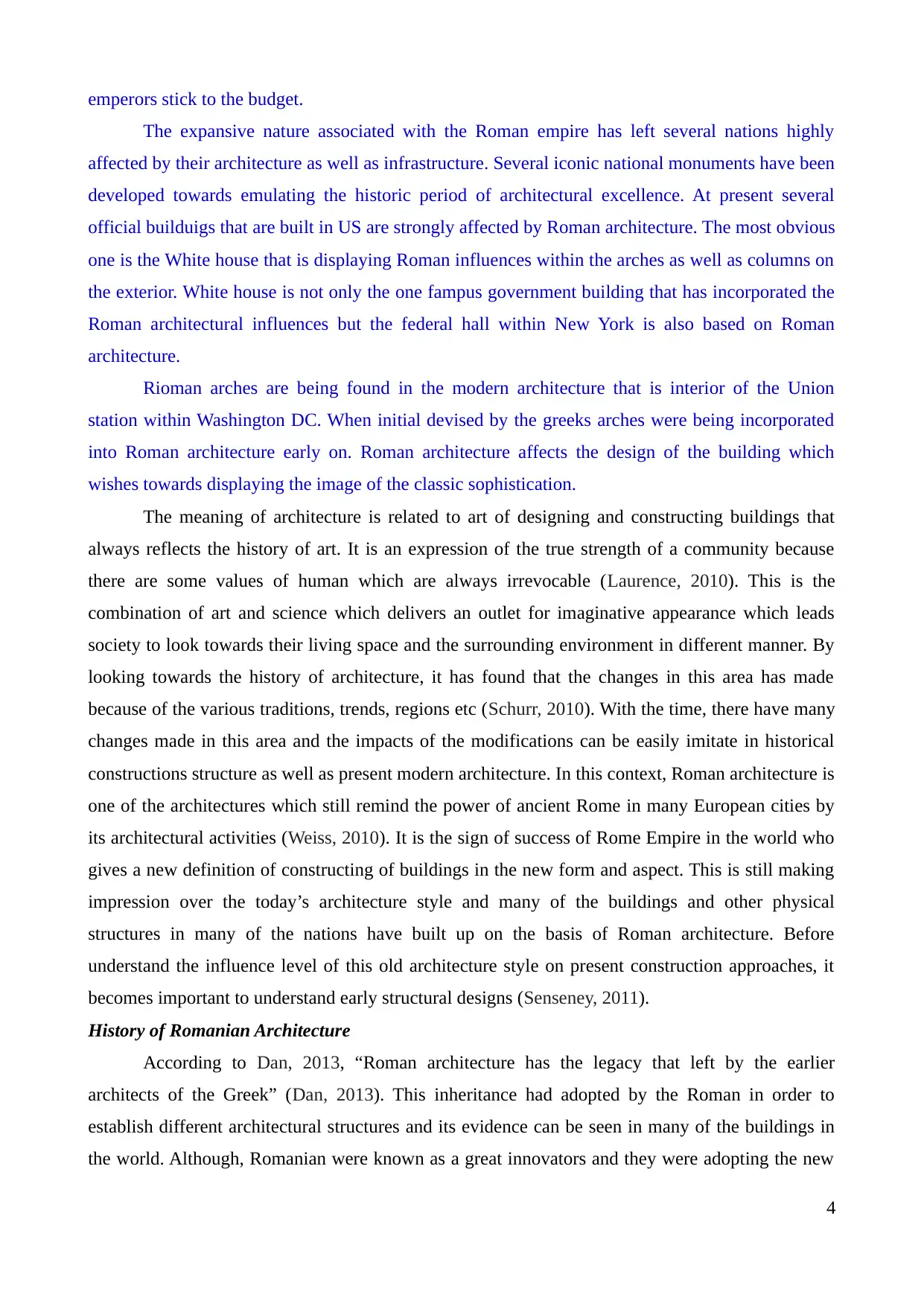
emperors stick to the budget.
The expansive nature associated with the Roman empire has left several nations highly
affected by their architecture as well as infrastructure. Several iconic national monuments have been
developed towards emulating the historic period of architectural excellence. At present several
official builduigs that are built in US are strongly affected by Roman architecture. The most obvious
one is the White house that is displaying Roman influences within the arches as well as columns on
the exterior. White house is not only the one fampus government building that has incorporated the
Roman architectural influences but the federal hall within New York is also based on Roman
architecture.
Rioman arches are being found in the modern architecture that is interior of the Union
station within Washington DC. When initial devised by the greeks arches were being incorporated
into Roman architecture early on. Roman architecture affects the design of the building which
wishes towards displaying the image of the classic sophistication.
The meaning of architecture is related to art of designing and constructing buildings that
always reflects the history of art. It is an expression of the true strength of a community because
there are some values of human which are always irrevocable (Laurence, 2010). This is the
combination of art and science which delivers an outlet for imaginative appearance which leads
society to look towards their living space and the surrounding environment in different manner. By
looking towards the history of architecture, it has found that the changes in this area has made
because of the various traditions, trends, regions etc (Schurr, 2010). With the time, there have many
changes made in this area and the impacts of the modifications can be easily imitate in historical
constructions structure as well as present modern architecture. In this context, Roman architecture is
one of the architectures which still remind the power of ancient Rome in many European cities by
its architectural activities (Weiss, 2010). It is the sign of success of Rome Empire in the world who
gives a new definition of constructing of buildings in the new form and aspect. This is still making
impression over the today’s architecture style and many of the buildings and other physical
structures in many of the nations have built up on the basis of Roman architecture. Before
understand the influence level of this old architecture style on present construction approaches, it
becomes important to understand early structural designs (Senseney, 2011).
History of Romanian Architecture
According to Dan, 2013, “Roman architecture has the legacy that left by the earlier
architects of the Greek” (Dan, 2013). This inheritance had adopted by the Roman in order to
establish different architectural structures and its evidence can be seen in many of the buildings in
the world. Although, Romanian were known as a great innovators and they were adopting the new
4
The expansive nature associated with the Roman empire has left several nations highly
affected by their architecture as well as infrastructure. Several iconic national monuments have been
developed towards emulating the historic period of architectural excellence. At present several
official builduigs that are built in US are strongly affected by Roman architecture. The most obvious
one is the White house that is displaying Roman influences within the arches as well as columns on
the exterior. White house is not only the one fampus government building that has incorporated the
Roman architectural influences but the federal hall within New York is also based on Roman
architecture.
Rioman arches are being found in the modern architecture that is interior of the Union
station within Washington DC. When initial devised by the greeks arches were being incorporated
into Roman architecture early on. Roman architecture affects the design of the building which
wishes towards displaying the image of the classic sophistication.
The meaning of architecture is related to art of designing and constructing buildings that
always reflects the history of art. It is an expression of the true strength of a community because
there are some values of human which are always irrevocable (Laurence, 2010). This is the
combination of art and science which delivers an outlet for imaginative appearance which leads
society to look towards their living space and the surrounding environment in different manner. By
looking towards the history of architecture, it has found that the changes in this area has made
because of the various traditions, trends, regions etc (Schurr, 2010). With the time, there have many
changes made in this area and the impacts of the modifications can be easily imitate in historical
constructions structure as well as present modern architecture. In this context, Roman architecture is
one of the architectures which still remind the power of ancient Rome in many European cities by
its architectural activities (Weiss, 2010). It is the sign of success of Rome Empire in the world who
gives a new definition of constructing of buildings in the new form and aspect. This is still making
impression over the today’s architecture style and many of the buildings and other physical
structures in many of the nations have built up on the basis of Roman architecture. Before
understand the influence level of this old architecture style on present construction approaches, it
becomes important to understand early structural designs (Senseney, 2011).
History of Romanian Architecture
According to Dan, 2013, “Roman architecture has the legacy that left by the earlier
architects of the Greek” (Dan, 2013). This inheritance had adopted by the Roman in order to
establish different architectural structures and its evidence can be seen in many of the buildings in
the world. Although, Romanian were known as a great innovators and they were adopting the new
4
Paraphrase This Document
Need a fresh take? Get an instant paraphrase of this document with our AI Paraphraser
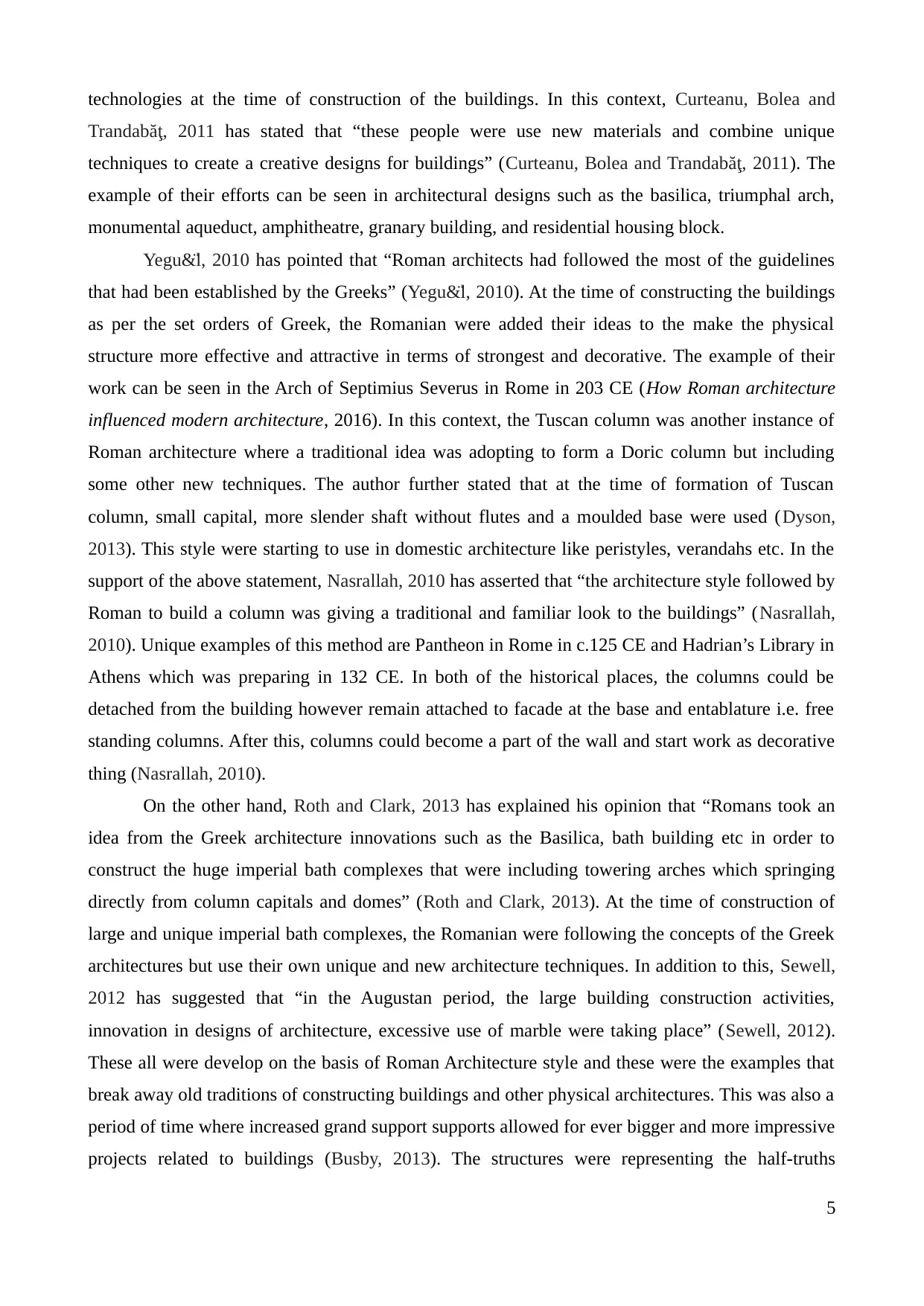
technologies at the time of construction of the buildings. In this context, Curteanu, Bolea and
Trandabăţ, 2011 has stated that “these people were use new materials and combine unique
techniques to create a creative designs for buildings” (Curteanu, Bolea and Trandabăţ, 2011). The
example of their efforts can be seen in architectural designs such as the basilica, triumphal arch,
monumental aqueduct, amphitheatre, granary building, and residential housing block.
Yegu&̈l, 2010 has pointed that “Roman architects had followed the most of the guidelines
that had been established by the Greeks” (Yegu&̈l, 2010). At the time of constructing the buildings
as per the set orders of Greek, the Romanian were added their ideas to the make the physical
structure more effective and attractive in terms of strongest and decorative. The example of their
work can be seen in the Arch of Septimius Severus in Rome in 203 CE (How Roman architecture
influenced modern architecture, 2016). In this context, the Tuscan column was another instance of
Roman architecture where a traditional idea was adopting to form a Doric column but including
some other new techniques. The author further stated that at the time of formation of Tuscan
column, small capital, more slender shaft without flutes and a moulded base were used (Dyson,
2013). This style were starting to use in domestic architecture like peristyles, verandahs etc. In the
support of the above statement, Nasrallah, 2010 has asserted that “the architecture style followed by
Roman to build a column was giving a traditional and familiar look to the buildings” (Nasrallah,
2010). Unique examples of this method are Pantheon in Rome in c.125 CE and Hadrian’s Library in
Athens which was preparing in 132 CE. In both of the historical places, the columns could be
detached from the building however remain attached to facade at the base and entablature i.e. free
standing columns. After this, columns could become a part of the wall and start work as decorative
thing (Nasrallah, 2010).
On the other hand, Roth and Clark, 2013 has explained his opinion that “Romans took an
idea from the Greek architecture innovations such as the Basilica, bath building etc in order to
construct the huge imperial bath complexes that were including towering arches which springing
directly from column capitals and domes” (Roth and Clark, 2013). At the time of construction of
large and unique imperial bath complexes, the Romanian were following the concepts of the Greek
architectures but use their own unique and new architecture techniques. In addition to this, Sewell,
2012 has suggested that “in the Augustan period, the large building construction activities,
innovation in designs of architecture, excessive use of marble were taking place” (Sewell, 2012).
These all were develop on the basis of Roman Architecture style and these were the examples that
break away old traditions of constructing buildings and other physical architectures. This was also a
period of time where increased grand support supports allowed for ever bigger and more impressive
projects related to buildings (Busby, 2013). The structures were representing the half-truths
5
Trandabăţ, 2011 has stated that “these people were use new materials and combine unique
techniques to create a creative designs for buildings” (Curteanu, Bolea and Trandabăţ, 2011). The
example of their efforts can be seen in architectural designs such as the basilica, triumphal arch,
monumental aqueduct, amphitheatre, granary building, and residential housing block.
Yegu&̈l, 2010 has pointed that “Roman architects had followed the most of the guidelines
that had been established by the Greeks” (Yegu&̈l, 2010). At the time of constructing the buildings
as per the set orders of Greek, the Romanian were added their ideas to the make the physical
structure more effective and attractive in terms of strongest and decorative. The example of their
work can be seen in the Arch of Septimius Severus in Rome in 203 CE (How Roman architecture
influenced modern architecture, 2016). In this context, the Tuscan column was another instance of
Roman architecture where a traditional idea was adopting to form a Doric column but including
some other new techniques. The author further stated that at the time of formation of Tuscan
column, small capital, more slender shaft without flutes and a moulded base were used (Dyson,
2013). This style were starting to use in domestic architecture like peristyles, verandahs etc. In the
support of the above statement, Nasrallah, 2010 has asserted that “the architecture style followed by
Roman to build a column was giving a traditional and familiar look to the buildings” (Nasrallah,
2010). Unique examples of this method are Pantheon in Rome in c.125 CE and Hadrian’s Library in
Athens which was preparing in 132 CE. In both of the historical places, the columns could be
detached from the building however remain attached to facade at the base and entablature i.e. free
standing columns. After this, columns could become a part of the wall and start work as decorative
thing (Nasrallah, 2010).
On the other hand, Roth and Clark, 2013 has explained his opinion that “Romans took an
idea from the Greek architecture innovations such as the Basilica, bath building etc in order to
construct the huge imperial bath complexes that were including towering arches which springing
directly from column capitals and domes” (Roth and Clark, 2013). At the time of construction of
large and unique imperial bath complexes, the Romanian were following the concepts of the Greek
architectures but use their own unique and new architecture techniques. In addition to this, Sewell,
2012 has suggested that “in the Augustan period, the large building construction activities,
innovation in designs of architecture, excessive use of marble were taking place” (Sewell, 2012).
These all were develop on the basis of Roman Architecture style and these were the examples that
break away old traditions of constructing buildings and other physical architectures. This was also a
period of time where increased grand support supports allowed for ever bigger and more impressive
projects related to buildings (Busby, 2013). The structures were representing the half-truths
5
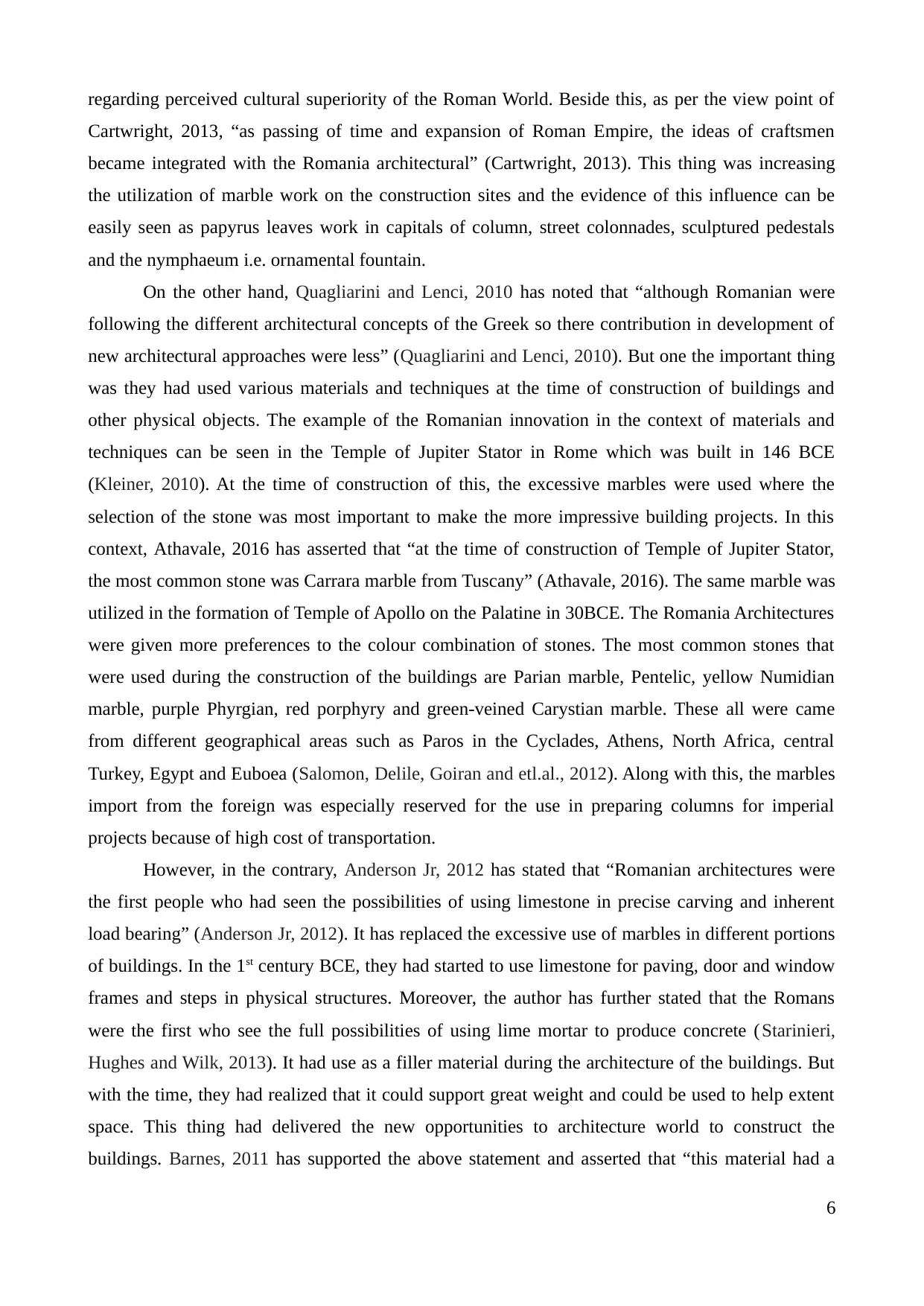
regarding perceived cultural superiority of the Roman World. Beside this, as per the view point of
Cartwright, 2013, “as passing of time and expansion of Roman Empire, the ideas of craftsmen
became integrated with the Romania architectural” (Cartwright, 2013). This thing was increasing
the utilization of marble work on the construction sites and the evidence of this influence can be
easily seen as papyrus leaves work in capitals of column, street colonnades, sculptured pedestals
and the nymphaeum i.e. ornamental fountain.
On the other hand, Quagliarini and Lenci, 2010 has noted that “although Romanian were
following the different architectural concepts of the Greek so there contribution in development of
new architectural approaches were less” (Quagliarini and Lenci, 2010). But one the important thing
was they had used various materials and techniques at the time of construction of buildings and
other physical objects. The example of the Romanian innovation in the context of materials and
techniques can be seen in the Temple of Jupiter Stator in Rome which was built in 146 BCE
(Kleiner, 2010). At the time of construction of this, the excessive marbles were used where the
selection of the stone was most important to make the more impressive building projects. In this
context, Athavale, 2016 has asserted that “at the time of construction of Temple of Jupiter Stator,
the most common stone was Carrara marble from Tuscany” (Athavale, 2016). The same marble was
utilized in the formation of Temple of Apollo on the Palatine in 30BCE. The Romania Architectures
were given more preferences to the colour combination of stones. The most common stones that
were used during the construction of the buildings are Parian marble, Pentelic, yellow Numidian
marble, purple Phyrgian, red porphyry and green-veined Carystian marble. These all were came
from different geographical areas such as Paros in the Cyclades, Athens, North Africa, central
Turkey, Egypt and Euboea (Salomon, Delile, Goiran and etl.al., 2012). Along with this, the marbles
import from the foreign was especially reserved for the use in preparing columns for imperial
projects because of high cost of transportation.
However, in the contrary, Anderson Jr, 2012 has stated that “Romanian architectures were
the first people who had seen the possibilities of using limestone in precise carving and inherent
load bearing” (Anderson Jr, 2012). It has replaced the excessive use of marbles in different portions
of buildings. In the 1st century BCE, they had started to use limestone for paving, door and window
frames and steps in physical structures. Moreover, the author has further stated that the Romans
were the first who see the full possibilities of using lime mortar to produce concrete (Starinieri,
Hughes and Wilk, 2013). It had use as a filler material during the architecture of the buildings. But
with the time, they had realized that it could support great weight and could be used to help extent
space. This thing had delivered the new opportunities to architecture world to construct the
buildings. Barnes, 2011 has supported the above statement and asserted that “this material had a
6
Cartwright, 2013, “as passing of time and expansion of Roman Empire, the ideas of craftsmen
became integrated with the Romania architectural” (Cartwright, 2013). This thing was increasing
the utilization of marble work on the construction sites and the evidence of this influence can be
easily seen as papyrus leaves work in capitals of column, street colonnades, sculptured pedestals
and the nymphaeum i.e. ornamental fountain.
On the other hand, Quagliarini and Lenci, 2010 has noted that “although Romanian were
following the different architectural concepts of the Greek so there contribution in development of
new architectural approaches were less” (Quagliarini and Lenci, 2010). But one the important thing
was they had used various materials and techniques at the time of construction of buildings and
other physical objects. The example of the Romanian innovation in the context of materials and
techniques can be seen in the Temple of Jupiter Stator in Rome which was built in 146 BCE
(Kleiner, 2010). At the time of construction of this, the excessive marbles were used where the
selection of the stone was most important to make the more impressive building projects. In this
context, Athavale, 2016 has asserted that “at the time of construction of Temple of Jupiter Stator,
the most common stone was Carrara marble from Tuscany” (Athavale, 2016). The same marble was
utilized in the formation of Temple of Apollo on the Palatine in 30BCE. The Romania Architectures
were given more preferences to the colour combination of stones. The most common stones that
were used during the construction of the buildings are Parian marble, Pentelic, yellow Numidian
marble, purple Phyrgian, red porphyry and green-veined Carystian marble. These all were came
from different geographical areas such as Paros in the Cyclades, Athens, North Africa, central
Turkey, Egypt and Euboea (Salomon, Delile, Goiran and etl.al., 2012). Along with this, the marbles
import from the foreign was especially reserved for the use in preparing columns for imperial
projects because of high cost of transportation.
However, in the contrary, Anderson Jr, 2012 has stated that “Romanian architectures were
the first people who had seen the possibilities of using limestone in precise carving and inherent
load bearing” (Anderson Jr, 2012). It has replaced the excessive use of marbles in different portions
of buildings. In the 1st century BCE, they had started to use limestone for paving, door and window
frames and steps in physical structures. Moreover, the author has further stated that the Romans
were the first who see the full possibilities of using lime mortar to produce concrete (Starinieri,
Hughes and Wilk, 2013). It had use as a filler material during the architecture of the buildings. But
with the time, they had realized that it could support great weight and could be used to help extent
space. This thing had delivered the new opportunities to architecture world to construct the
buildings. Barnes, 2011 has supported the above statement and asserted that “this material had a
6
⊘ This is a preview!⊘
Do you want full access?
Subscribe today to unlock all pages.

Trusted by 1+ million students worldwide
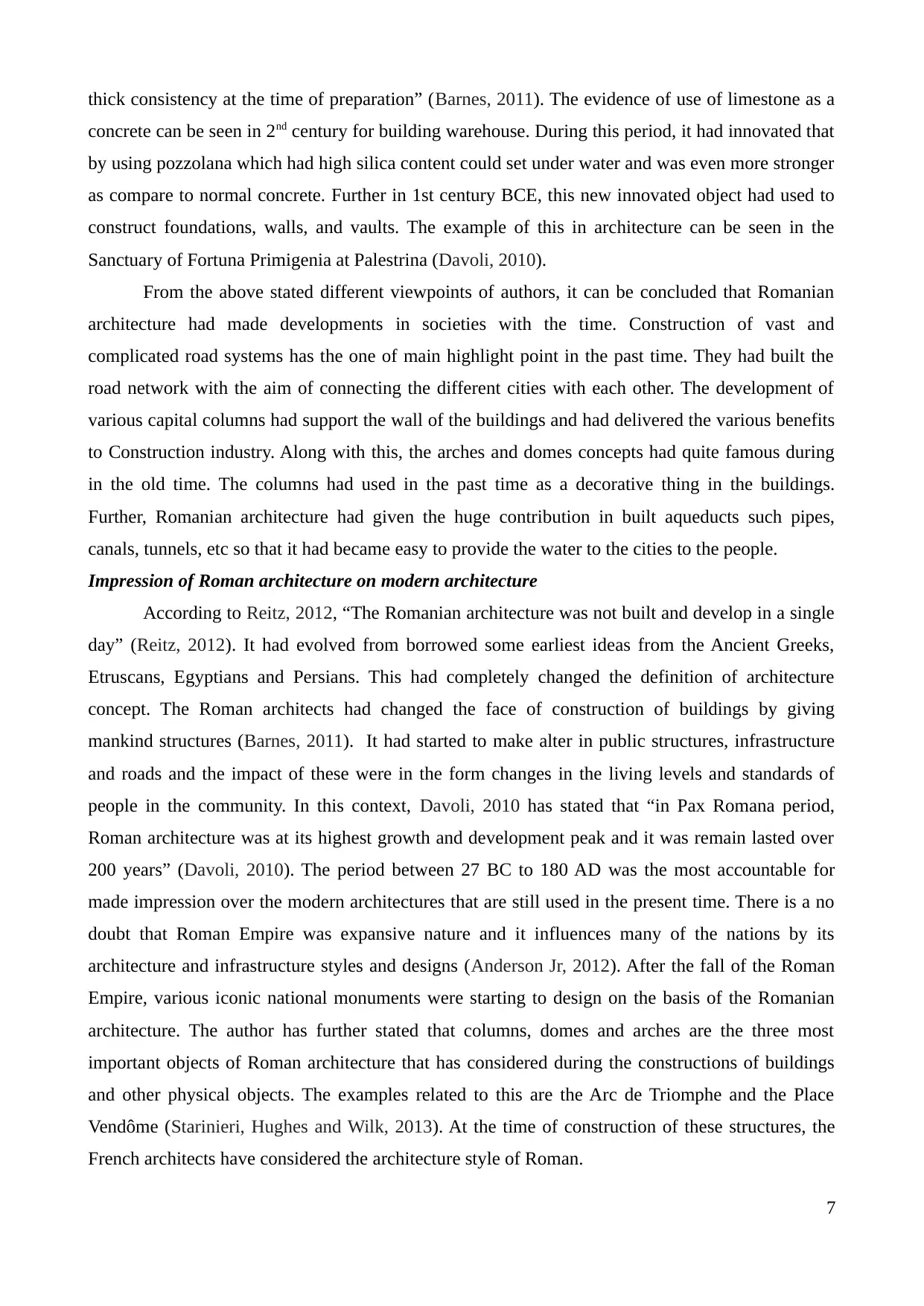
thick consistency at the time of preparation” (Barnes, 2011). The evidence of use of limestone as a
concrete can be seen in 2nd century for building warehouse. During this period, it had innovated that
by using pozzolana which had high silica content could set under water and was even more stronger
as compare to normal concrete. Further in 1st century BCE, this new innovated object had used to
construct foundations, walls, and vaults. The example of this in architecture can be seen in the
Sanctuary of Fortuna Primigenia at Palestrina (Davoli, 2010).
From the above stated different viewpoints of authors, it can be concluded that Romanian
architecture had made developments in societies with the time. Construction of vast and
complicated road systems has the one of main highlight point in the past time. They had built the
road network with the aim of connecting the different cities with each other. The development of
various capital columns had support the wall of the buildings and had delivered the various benefits
to Construction industry. Along with this, the arches and domes concepts had quite famous during
in the old time. The columns had used in the past time as a decorative thing in the buildings.
Further, Romanian architecture had given the huge contribution in built aqueducts such pipes,
canals, tunnels, etc so that it had became easy to provide the water to the cities to the people.
Impression of Roman architecture on modern architecture
According to Reitz, 2012, “The Romanian architecture was not built and develop in a single
day” (Reitz, 2012). It had evolved from borrowed some earliest ideas from the Ancient Greeks,
Etruscans, Egyptians and Persians. This had completely changed the definition of architecture
concept. The Roman architects had changed the face of construction of buildings by giving
mankind structures (Barnes, 2011). It had started to make alter in public structures, infrastructure
and roads and the impact of these were in the form changes in the living levels and standards of
people in the community. In this context, Davoli, 2010 has stated that “in Pax Romana period,
Roman architecture was at its highest growth and development peak and it was remain lasted over
200 years” (Davoli, 2010). The period between 27 BC to 180 AD was the most accountable for
made impression over the modern architectures that are still used in the present time. There is a no
doubt that Roman Empire was expansive nature and it influences many of the nations by its
architecture and infrastructure styles and designs (Anderson Jr, 2012). After the fall of the Roman
Empire, various iconic national monuments were starting to design on the basis of the Romanian
architecture. The author has further stated that columns, domes and arches are the three most
important objects of Roman architecture that has considered during the constructions of buildings
and other physical objects. The examples related to this are the Arc de Triomphe and the Place
Vendôme (Starinieri, Hughes and Wilk, 2013). At the time of construction of these structures, the
French architects have considered the architecture style of Roman.
7
concrete can be seen in 2nd century for building warehouse. During this period, it had innovated that
by using pozzolana which had high silica content could set under water and was even more stronger
as compare to normal concrete. Further in 1st century BCE, this new innovated object had used to
construct foundations, walls, and vaults. The example of this in architecture can be seen in the
Sanctuary of Fortuna Primigenia at Palestrina (Davoli, 2010).
From the above stated different viewpoints of authors, it can be concluded that Romanian
architecture had made developments in societies with the time. Construction of vast and
complicated road systems has the one of main highlight point in the past time. They had built the
road network with the aim of connecting the different cities with each other. The development of
various capital columns had support the wall of the buildings and had delivered the various benefits
to Construction industry. Along with this, the arches and domes concepts had quite famous during
in the old time. The columns had used in the past time as a decorative thing in the buildings.
Further, Romanian architecture had given the huge contribution in built aqueducts such pipes,
canals, tunnels, etc so that it had became easy to provide the water to the cities to the people.
Impression of Roman architecture on modern architecture
According to Reitz, 2012, “The Romanian architecture was not built and develop in a single
day” (Reitz, 2012). It had evolved from borrowed some earliest ideas from the Ancient Greeks,
Etruscans, Egyptians and Persians. This had completely changed the definition of architecture
concept. The Roman architects had changed the face of construction of buildings by giving
mankind structures (Barnes, 2011). It had started to make alter in public structures, infrastructure
and roads and the impact of these were in the form changes in the living levels and standards of
people in the community. In this context, Davoli, 2010 has stated that “in Pax Romana period,
Roman architecture was at its highest growth and development peak and it was remain lasted over
200 years” (Davoli, 2010). The period between 27 BC to 180 AD was the most accountable for
made impression over the modern architectures that are still used in the present time. There is a no
doubt that Roman Empire was expansive nature and it influences many of the nations by its
architecture and infrastructure styles and designs (Anderson Jr, 2012). After the fall of the Roman
Empire, various iconic national monuments were starting to design on the basis of the Romanian
architecture. The author has further stated that columns, domes and arches are the three most
important objects of Roman architecture that has considered during the constructions of buildings
and other physical objects. The examples related to this are the Arc de Triomphe and the Place
Vendôme (Starinieri, Hughes and Wilk, 2013). At the time of construction of these structures, the
French architects have considered the architecture style of Roman.
7
Paraphrase This Document
Need a fresh take? Get an instant paraphrase of this document with our AI Paraphraser
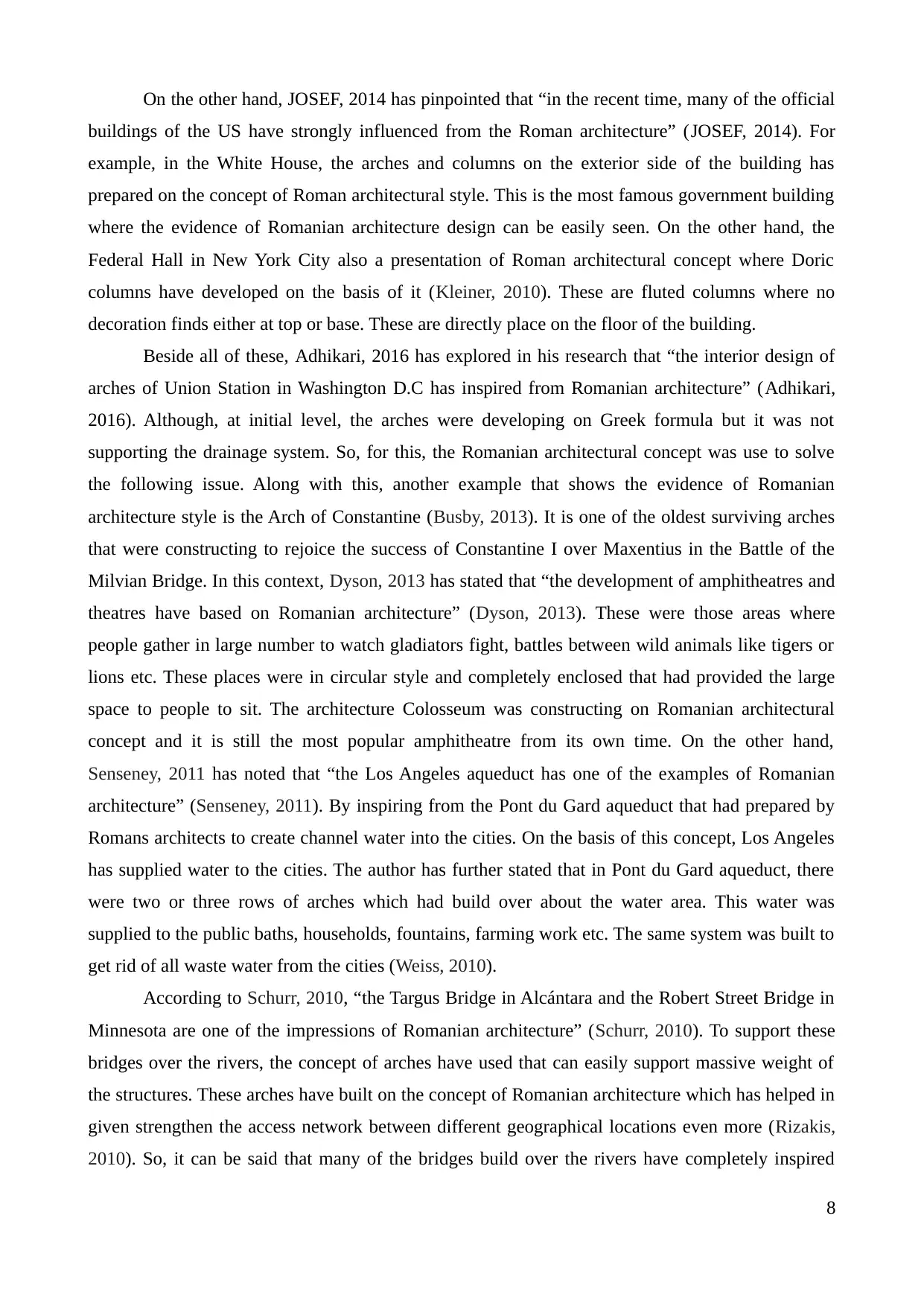
On the other hand, JOSEF, 2014 has pinpointed that “in the recent time, many of the official
buildings of the US have strongly influenced from the Roman architecture” (JOSEF, 2014). For
example, in the White House, the arches and columns on the exterior side of the building has
prepared on the concept of Roman architectural style. This is the most famous government building
where the evidence of Romanian architecture design can be easily seen. On the other hand, the
Federal Hall in New York City also a presentation of Roman architectural concept where Doric
columns have developed on the basis of it (Kleiner, 2010). These are fluted columns where no
decoration finds either at top or base. These are directly place on the floor of the building.
Beside all of these, Adhikari, 2016 has explored in his research that “the interior design of
arches of Union Station in Washington D.C has inspired from Romanian architecture” (Adhikari,
2016). Although, at initial level, the arches were developing on Greek formula but it was not
supporting the drainage system. So, for this, the Romanian architectural concept was use to solve
the following issue. Along with this, another example that shows the evidence of Romanian
architecture style is the Arch of Constantine (Busby, 2013). It is one of the oldest surviving arches
that were constructing to rejoice the success of Constantine I over Maxentius in the Battle of the
Milvian Bridge. In this context, Dyson, 2013 has stated that “the development of amphitheatres and
theatres have based on Romanian architecture” (Dyson, 2013). These were those areas where
people gather in large number to watch gladiators fight, battles between wild animals like tigers or
lions etc. These places were in circular style and completely enclosed that had provided the large
space to people to sit. The architecture Colosseum was constructing on Romanian architectural
concept and it is still the most popular amphitheatre from its own time. On the other hand,
Senseney, 2011 has noted that “the Los Angeles aqueduct has one of the examples of Romanian
architecture” (Senseney, 2011). By inspiring from the Pont du Gard aqueduct that had prepared by
Romans architects to create channel water into the cities. On the basis of this concept, Los Angeles
has supplied water to the cities. The author has further stated that in Pont du Gard aqueduct, there
were two or three rows of arches which had build over about the water area. This water was
supplied to the public baths, households, fountains, farming work etc. The same system was built to
get rid of all waste water from the cities (Weiss, 2010).
According to Schurr, 2010, “the Targus Bridge in Alcántara and the Robert Street Bridge in
Minnesota are one of the impressions of Romanian architecture” (Schurr, 2010). To support these
bridges over the rivers, the concept of arches have used that can easily support massive weight of
the structures. These arches have built on the concept of Romanian architecture which has helped in
given strengthen the access network between different geographical locations even more (Rizakis,
2010). So, it can be said that many of the bridges build over the rivers have completely inspired
8
buildings of the US have strongly influenced from the Roman architecture” (JOSEF, 2014). For
example, in the White House, the arches and columns on the exterior side of the building has
prepared on the concept of Roman architectural style. This is the most famous government building
where the evidence of Romanian architecture design can be easily seen. On the other hand, the
Federal Hall in New York City also a presentation of Roman architectural concept where Doric
columns have developed on the basis of it (Kleiner, 2010). These are fluted columns where no
decoration finds either at top or base. These are directly place on the floor of the building.
Beside all of these, Adhikari, 2016 has explored in his research that “the interior design of
arches of Union Station in Washington D.C has inspired from Romanian architecture” (Adhikari,
2016). Although, at initial level, the arches were developing on Greek formula but it was not
supporting the drainage system. So, for this, the Romanian architectural concept was use to solve
the following issue. Along with this, another example that shows the evidence of Romanian
architecture style is the Arch of Constantine (Busby, 2013). It is one of the oldest surviving arches
that were constructing to rejoice the success of Constantine I over Maxentius in the Battle of the
Milvian Bridge. In this context, Dyson, 2013 has stated that “the development of amphitheatres and
theatres have based on Romanian architecture” (Dyson, 2013). These were those areas where
people gather in large number to watch gladiators fight, battles between wild animals like tigers or
lions etc. These places were in circular style and completely enclosed that had provided the large
space to people to sit. The architecture Colosseum was constructing on Romanian architectural
concept and it is still the most popular amphitheatre from its own time. On the other hand,
Senseney, 2011 has noted that “the Los Angeles aqueduct has one of the examples of Romanian
architecture” (Senseney, 2011). By inspiring from the Pont du Gard aqueduct that had prepared by
Romans architects to create channel water into the cities. On the basis of this concept, Los Angeles
has supplied water to the cities. The author has further stated that in Pont du Gard aqueduct, there
were two or three rows of arches which had build over about the water area. This water was
supplied to the public baths, households, fountains, farming work etc. The same system was built to
get rid of all waste water from the cities (Weiss, 2010).
According to Schurr, 2010, “the Targus Bridge in Alcántara and the Robert Street Bridge in
Minnesota are one of the impressions of Romanian architecture” (Schurr, 2010). To support these
bridges over the rivers, the concept of arches have used that can easily support massive weight of
the structures. These arches have built on the concept of Romanian architecture which has helped in
given strengthen the access network between different geographical locations even more (Rizakis,
2010). So, it can be said that many of the bridges build over the rivers have completely inspired
8
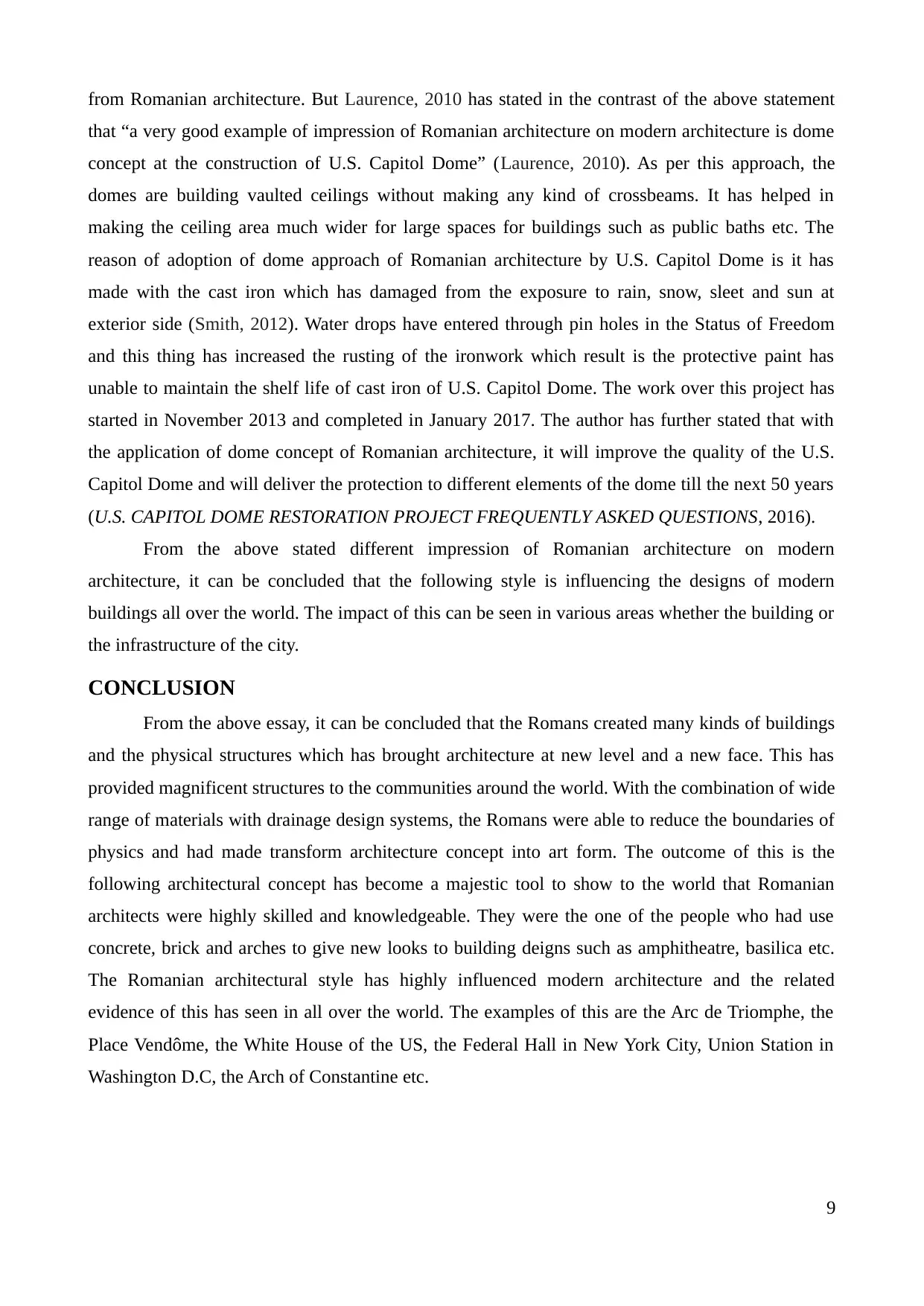
from Romanian architecture. But Laurence, 2010 has stated in the contrast of the above statement
that “a very good example of impression of Romanian architecture on modern architecture is dome
concept at the construction of U.S. Capitol Dome” (Laurence, 2010). As per this approach, the
domes are building vaulted ceilings without making any kind of crossbeams. It has helped in
making the ceiling area much wider for large spaces for buildings such as public baths etc. The
reason of adoption of dome approach of Romanian architecture by U.S. Capitol Dome is it has
made with the cast iron which has damaged from the exposure to rain, snow, sleet and sun at
exterior side (Smith, 2012). Water drops have entered through pin holes in the Status of Freedom
and this thing has increased the rusting of the ironwork which result is the protective paint has
unable to maintain the shelf life of cast iron of U.S. Capitol Dome. The work over this project has
started in November 2013 and completed in January 2017. The author has further stated that with
the application of dome concept of Romanian architecture, it will improve the quality of the U.S.
Capitol Dome and will deliver the protection to different elements of the dome till the next 50 years
(U.S. CAPITOL DOME RESTORATION PROJECT FREQUENTLY ASKED QUESTIONS, 2016).
From the above stated different impression of Romanian architecture on modern
architecture, it can be concluded that the following style is influencing the designs of modern
buildings all over the world. The impact of this can be seen in various areas whether the building or
the infrastructure of the city.
CONCLUSION
From the above essay, it can be concluded that the Romans created many kinds of buildings
and the physical structures which has brought architecture at new level and a new face. This has
provided magnificent structures to the communities around the world. With the combination of wide
range of materials with drainage design systems, the Romans were able to reduce the boundaries of
physics and had made transform architecture concept into art form. The outcome of this is the
following architectural concept has become a majestic tool to show to the world that Romanian
architects were highly skilled and knowledgeable. They were the one of the people who had use
concrete, brick and arches to give new looks to building deigns such as amphitheatre, basilica etc.
The Romanian architectural style has highly influenced modern architecture and the related
evidence of this has seen in all over the world. The examples of this are the Arc de Triomphe, the
Place Vendôme, the White House of the US, the Federal Hall in New York City, Union Station in
Washington D.C, the Arch of Constantine etc.
9
that “a very good example of impression of Romanian architecture on modern architecture is dome
concept at the construction of U.S. Capitol Dome” (Laurence, 2010). As per this approach, the
domes are building vaulted ceilings without making any kind of crossbeams. It has helped in
making the ceiling area much wider for large spaces for buildings such as public baths etc. The
reason of adoption of dome approach of Romanian architecture by U.S. Capitol Dome is it has
made with the cast iron which has damaged from the exposure to rain, snow, sleet and sun at
exterior side (Smith, 2012). Water drops have entered through pin holes in the Status of Freedom
and this thing has increased the rusting of the ironwork which result is the protective paint has
unable to maintain the shelf life of cast iron of U.S. Capitol Dome. The work over this project has
started in November 2013 and completed in January 2017. The author has further stated that with
the application of dome concept of Romanian architecture, it will improve the quality of the U.S.
Capitol Dome and will deliver the protection to different elements of the dome till the next 50 years
(U.S. CAPITOL DOME RESTORATION PROJECT FREQUENTLY ASKED QUESTIONS, 2016).
From the above stated different impression of Romanian architecture on modern
architecture, it can be concluded that the following style is influencing the designs of modern
buildings all over the world. The impact of this can be seen in various areas whether the building or
the infrastructure of the city.
CONCLUSION
From the above essay, it can be concluded that the Romans created many kinds of buildings
and the physical structures which has brought architecture at new level and a new face. This has
provided magnificent structures to the communities around the world. With the combination of wide
range of materials with drainage design systems, the Romans were able to reduce the boundaries of
physics and had made transform architecture concept into art form. The outcome of this is the
following architectural concept has become a majestic tool to show to the world that Romanian
architects were highly skilled and knowledgeable. They were the one of the people who had use
concrete, brick and arches to give new looks to building deigns such as amphitheatre, basilica etc.
The Romanian architectural style has highly influenced modern architecture and the related
evidence of this has seen in all over the world. The examples of this are the Arc de Triomphe, the
Place Vendôme, the White House of the US, the Federal Hall in New York City, Union Station in
Washington D.C, the Arch of Constantine etc.
9
⊘ This is a preview!⊘
Do you want full access?
Subscribe today to unlock all pages.

Trusted by 1+ million students worldwide
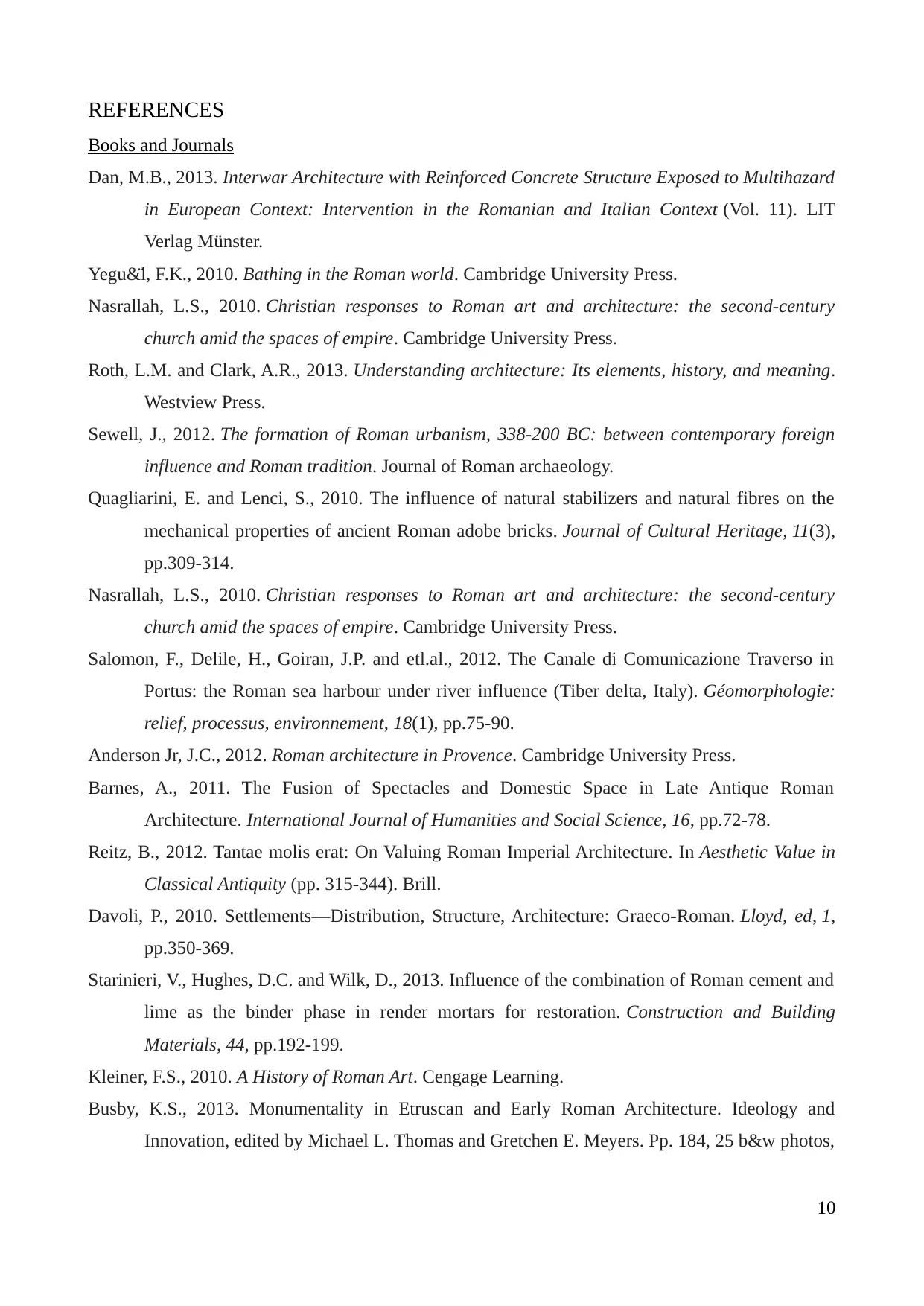
REFERENCES
Books and Journals
Dan, M.B., 2013. Interwar Architecture with Reinforced Concrete Structure Exposed to Multihazard
in European Context: Intervention in the Romanian and Italian Context (Vol. 11). LIT
Verlag Münster.
Yegu&̈l, F.K., 2010. Bathing in the Roman world. Cambridge University Press.
Nasrallah, L.S., 2010. Christian responses to Roman art and architecture: the second-century
church amid the spaces of empire. Cambridge University Press.
Roth, L.M. and Clark, A.R., 2013. Understanding architecture: Its elements, history, and meaning.
Westview Press.
Sewell, J., 2012. The formation of Roman urbanism, 338-200 BC: between contemporary foreign
influence and Roman tradition. Journal of Roman archaeology.
Quagliarini, E. and Lenci, S., 2010. The influence of natural stabilizers and natural fibres on the
mechanical properties of ancient Roman adobe bricks. Journal of Cultural Heritage, 11(3),
pp.309-314.
Nasrallah, L.S., 2010. Christian responses to Roman art and architecture: the second-century
church amid the spaces of empire. Cambridge University Press.
Salomon, F., Delile, H., Goiran, J.P. and etl.al., 2012. The Canale di Comunicazione Traverso in
Portus: the Roman sea harbour under river influence (Tiber delta, Italy). Géomorphologie:
relief, processus, environnement, 18(1), pp.75-90.
Anderson Jr, J.C., 2012. Roman architecture in Provence. Cambridge University Press.
Barnes, A., 2011. The Fusion of Spectacles and Domestic Space in Late Antique Roman
Architecture. International Journal of Humanities and Social Science, 16, pp.72-78.
Reitz, B., 2012. Tantae molis erat: On Valuing Roman Imperial Architecture. In Aesthetic Value in
Classical Antiquity (pp. 315-344). Brill.
Davoli, P., 2010. Settlements—Distribution, Structure, Architecture: Graeco-Roman. Lloyd, ed, 1,
pp.350-369.
Starinieri, V., Hughes, D.C. and Wilk, D., 2013. Influence of the combination of Roman cement and
lime as the binder phase in render mortars for restoration. Construction and Building
Materials, 44, pp.192-199.
Kleiner, F.S., 2010. A History of Roman Art. Cengage Learning.
Busby, K.S., 2013. Monumentality in Etruscan and Early Roman Architecture. Ideology and
Innovation, edited by Michael L. Thomas and Gretchen E. Meyers. Pp. 184, 25 b&w photos,
10
Books and Journals
Dan, M.B., 2013. Interwar Architecture with Reinforced Concrete Structure Exposed to Multihazard
in European Context: Intervention in the Romanian and Italian Context (Vol. 11). LIT
Verlag Münster.
Yegu&̈l, F.K., 2010. Bathing in the Roman world. Cambridge University Press.
Nasrallah, L.S., 2010. Christian responses to Roman art and architecture: the second-century
church amid the spaces of empire. Cambridge University Press.
Roth, L.M. and Clark, A.R., 2013. Understanding architecture: Its elements, history, and meaning.
Westview Press.
Sewell, J., 2012. The formation of Roman urbanism, 338-200 BC: between contemporary foreign
influence and Roman tradition. Journal of Roman archaeology.
Quagliarini, E. and Lenci, S., 2010. The influence of natural stabilizers and natural fibres on the
mechanical properties of ancient Roman adobe bricks. Journal of Cultural Heritage, 11(3),
pp.309-314.
Nasrallah, L.S., 2010. Christian responses to Roman art and architecture: the second-century
church amid the spaces of empire. Cambridge University Press.
Salomon, F., Delile, H., Goiran, J.P. and etl.al., 2012. The Canale di Comunicazione Traverso in
Portus: the Roman sea harbour under river influence (Tiber delta, Italy). Géomorphologie:
relief, processus, environnement, 18(1), pp.75-90.
Anderson Jr, J.C., 2012. Roman architecture in Provence. Cambridge University Press.
Barnes, A., 2011. The Fusion of Spectacles and Domestic Space in Late Antique Roman
Architecture. International Journal of Humanities and Social Science, 16, pp.72-78.
Reitz, B., 2012. Tantae molis erat: On Valuing Roman Imperial Architecture. In Aesthetic Value in
Classical Antiquity (pp. 315-344). Brill.
Davoli, P., 2010. Settlements—Distribution, Structure, Architecture: Graeco-Roman. Lloyd, ed, 1,
pp.350-369.
Starinieri, V., Hughes, D.C. and Wilk, D., 2013. Influence of the combination of Roman cement and
lime as the binder phase in render mortars for restoration. Construction and Building
Materials, 44, pp.192-199.
Kleiner, F.S., 2010. A History of Roman Art. Cengage Learning.
Busby, K.S., 2013. Monumentality in Etruscan and Early Roman Architecture. Ideology and
Innovation, edited by Michael L. Thomas and Gretchen E. Meyers. Pp. 184, 25 b&w photos,
10
Paraphrase This Document
Need a fresh take? Get an instant paraphrase of this document with our AI Paraphraser
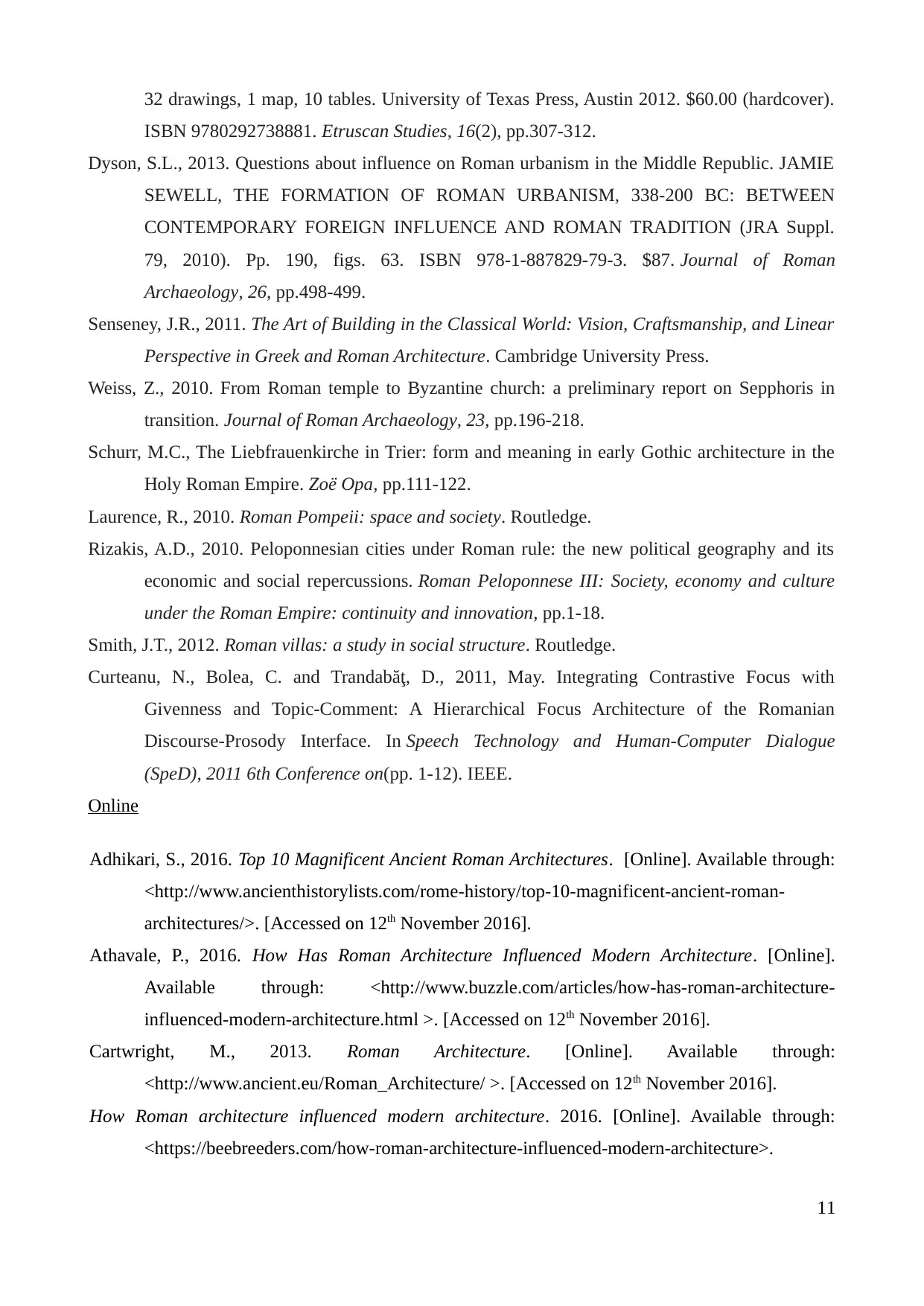
32 drawings, 1 map, 10 tables. University of Texas Press, Austin 2012. $60.00 (hardcover).
ISBN 9780292738881. Etruscan Studies, 16(2), pp.307-312.
Dyson, S.L., 2013. Questions about influence on Roman urbanism in the Middle Republic. JAMIE
SEWELL, THE FORMATION OF ROMAN URBANISM, 338-200 BC: BETWEEN
CONTEMPORARY FOREIGN INFLUENCE AND ROMAN TRADITION (JRA Suppl.
79, 2010). Pp. 190, figs. 63. ISBN 978-1-887829-79-3. $87. Journal of Roman
Archaeology, 26, pp.498-499.
Senseney, J.R., 2011. The Art of Building in the Classical World: Vision, Craftsmanship, and Linear
Perspective in Greek and Roman Architecture. Cambridge University Press.
Weiss, Z., 2010. From Roman temple to Byzantine church: a preliminary report on Sepphoris in
transition. Journal of Roman Archaeology, 23, pp.196-218.
Schurr, M.C., The Liebfrauenkirche in Trier: form and meaning in early Gothic architecture in the
Holy Roman Empire. Zoë Opa, pp.111-122.
Laurence, R., 2010. Roman Pompeii: space and society. Routledge.
Rizakis, A.D., 2010. Peloponnesian cities under Roman rule: the new political geography and its
economic and social repercussions. Roman Peloponnese III: Society, economy and culture
under the Roman Empire: continuity and innovation, pp.1-18.
Smith, J.T., 2012. Roman villas: a study in social structure. Routledge.
Curteanu, N., Bolea, C. and Trandabăţ, D., 2011, May. Integrating Contrastive Focus with
Givenness and Topic-Comment: A Hierarchical Focus Architecture of the Romanian
Discourse-Prosody Interface. In Speech Technology and Human-Computer Dialogue
(SpeD), 2011 6th Conference on(pp. 1-12). IEEE.
Online
Adhikari, S., 2016. Top 10 Magnificent Ancient Roman Architectures. [Online]. Available through:
<http://www.ancienthistorylists.com/rome-history/top-10-magnificent-ancient-roman-
architectures/>. [Accessed on 12th November 2016].
Athavale, P., 2016. How Has Roman Architecture Influenced Modern Architecture. [Online].
Available through: <http://www.buzzle.com/articles/how-has-roman-architecture-
influenced-modern-architecture.html >. [Accessed on 12th November 2016].
Cartwright, M., 2013. Roman Architecture. [Online]. Available through:
<http://www.ancient.eu/Roman_Architecture/ >. [Accessed on 12th November 2016].
How Roman architecture influenced modern architecture. 2016. [Online]. Available through:
<https://beebreeders.com/how-roman-architecture-influenced-modern-architecture>.
11
ISBN 9780292738881. Etruscan Studies, 16(2), pp.307-312.
Dyson, S.L., 2013. Questions about influence on Roman urbanism in the Middle Republic. JAMIE
SEWELL, THE FORMATION OF ROMAN URBANISM, 338-200 BC: BETWEEN
CONTEMPORARY FOREIGN INFLUENCE AND ROMAN TRADITION (JRA Suppl.
79, 2010). Pp. 190, figs. 63. ISBN 978-1-887829-79-3. $87. Journal of Roman
Archaeology, 26, pp.498-499.
Senseney, J.R., 2011. The Art of Building in the Classical World: Vision, Craftsmanship, and Linear
Perspective in Greek and Roman Architecture. Cambridge University Press.
Weiss, Z., 2010. From Roman temple to Byzantine church: a preliminary report on Sepphoris in
transition. Journal of Roman Archaeology, 23, pp.196-218.
Schurr, M.C., The Liebfrauenkirche in Trier: form and meaning in early Gothic architecture in the
Holy Roman Empire. Zoë Opa, pp.111-122.
Laurence, R., 2010. Roman Pompeii: space and society. Routledge.
Rizakis, A.D., 2010. Peloponnesian cities under Roman rule: the new political geography and its
economic and social repercussions. Roman Peloponnese III: Society, economy and culture
under the Roman Empire: continuity and innovation, pp.1-18.
Smith, J.T., 2012. Roman villas: a study in social structure. Routledge.
Curteanu, N., Bolea, C. and Trandabăţ, D., 2011, May. Integrating Contrastive Focus with
Givenness and Topic-Comment: A Hierarchical Focus Architecture of the Romanian
Discourse-Prosody Interface. In Speech Technology and Human-Computer Dialogue
(SpeD), 2011 6th Conference on(pp. 1-12). IEEE.
Online
Adhikari, S., 2016. Top 10 Magnificent Ancient Roman Architectures. [Online]. Available through:
<http://www.ancienthistorylists.com/rome-history/top-10-magnificent-ancient-roman-
architectures/>. [Accessed on 12th November 2016].
Athavale, P., 2016. How Has Roman Architecture Influenced Modern Architecture. [Online].
Available through: <http://www.buzzle.com/articles/how-has-roman-architecture-
influenced-modern-architecture.html >. [Accessed on 12th November 2016].
Cartwright, M., 2013. Roman Architecture. [Online]. Available through:
<http://www.ancient.eu/Roman_Architecture/ >. [Accessed on 12th November 2016].
How Roman architecture influenced modern architecture. 2016. [Online]. Available through:
<https://beebreeders.com/how-roman-architecture-influenced-modern-architecture>.
11

[Accessed on 12th November 2016].
JOSEF , 2014. 25 Impressive Examples Of Roman Architecture. [Online]. Available through:
<http://list25.com/25-impressive-examples-roman-architecture/5/>. [Accessed on 12th
November 2016].
U.S. CAPITOL DOME RESTORATION PROJECT FREQUENTLY ASKED QUESTIONS. 2016.
[Online]. Available through: <https://www.aoc.gov/dome/faqs>. [Accessed on 12th
November 2016].
12
JOSEF , 2014. 25 Impressive Examples Of Roman Architecture. [Online]. Available through:
<http://list25.com/25-impressive-examples-roman-architecture/5/>. [Accessed on 12th
November 2016].
U.S. CAPITOL DOME RESTORATION PROJECT FREQUENTLY ASKED QUESTIONS. 2016.
[Online]. Available through: <https://www.aoc.gov/dome/faqs>. [Accessed on 12th
November 2016].
12
⊘ This is a preview!⊘
Do you want full access?
Subscribe today to unlock all pages.

Trusted by 1+ million students worldwide
1 out of 12
Your All-in-One AI-Powered Toolkit for Academic Success.
+13062052269
info@desklib.com
Available 24*7 on WhatsApp / Email
![[object Object]](/_next/static/media/star-bottom.7253800d.svg)
Unlock your academic potential
Copyright © 2020–2025 A2Z Services. All Rights Reserved. Developed and managed by ZUCOL.
